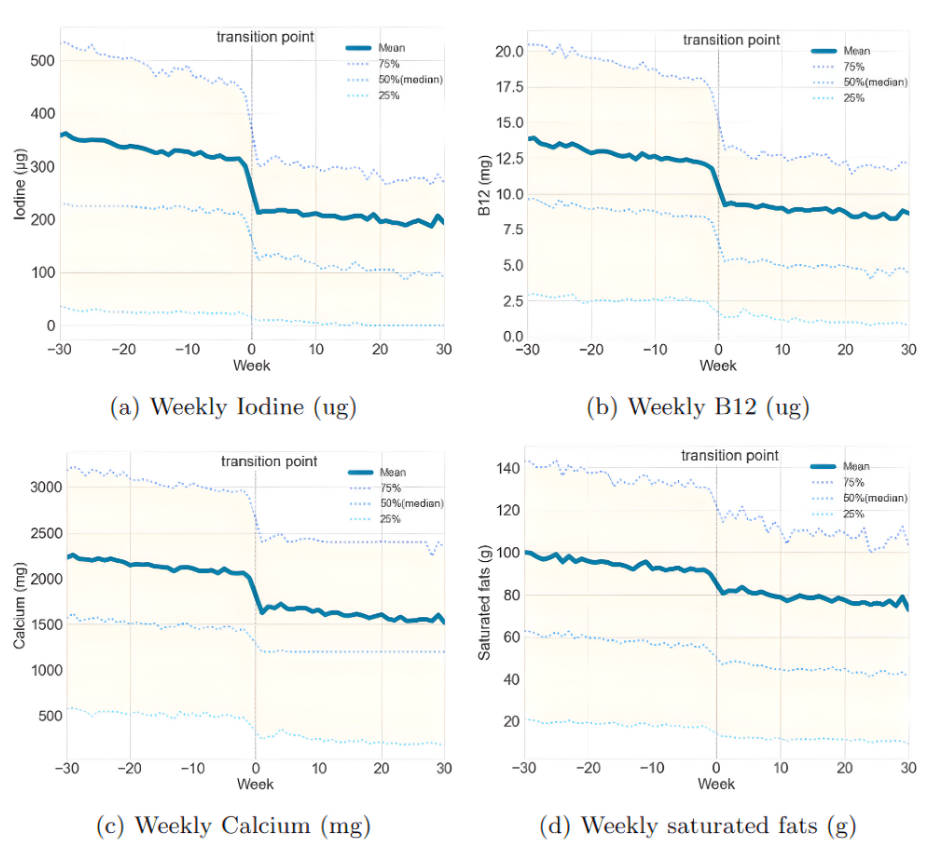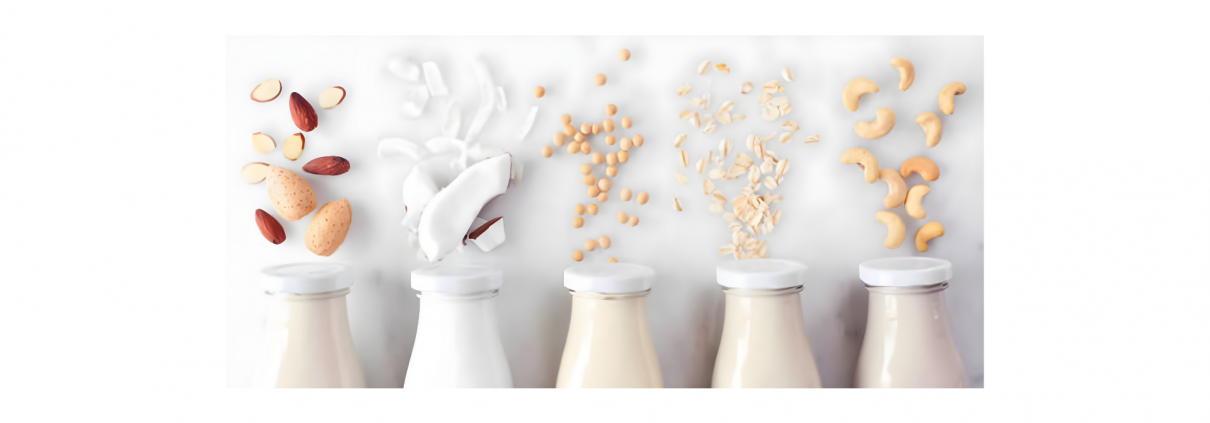Detecting iodine deficiencies from dietary transitions using shopping data
Our examination of anonymized loyalty-card shopping records from Co-op Food, UK suggests that dietary transitions – such as replacing milk with alternative milk – could lead to nutritional deficiencies, notably iodine, which, if not addressed, may represent a significant public health concern, particularly in countries that do not mandate salt iodisation.
Plant-based product replacements are gaining popularity. However, the long-term health implications remain poorly understood, and available methods, though accurate, are expensive and burdensome, impeding the study of sufficiently large cohorts. To identify dietary transitions over time, we examine anonymized loyalty-card shopping records from Co-op Food, UK. We focus on 10,626 frequent customers who directly replaced milk with alternative milk. We then use product nutritional information to estimate weekly nutrient intake before and after the transition. 83% who converted to alternative milk saw a fall in iodine (44%), calcium (30%), and vitamin B12 (39%) consumption, with 57% reducing iodine purchase by more than 50%. The decline is even higher for those switching dairy and meat products. Our findings suggest that dietary transitions – such as replacing milk with alternative milk – could lead to nutritional deficiencies, notably iodine, which, if not addressed, may represent a significant public health concern, particularly in countries that do not mandate salt iodisation.
Strictly anonymised data covering store transactions over 2.5 years (July 2019-December 2021) for over 4 million co-op members was filtered using predefined exclusion criteria to identify representative frequent customers making significant food purchases. This process identified more than 500,000 frequent shoppers. This sample was then used to establish shopping trajectories where logs exhibited dietary transitions during the study period, specifically regarding milk and dairy exclusion, finding 10,626 applicable accounts. Nutritional mapping linked the data to the retailer’s food products, specifically concentrating on iodine-rich items, matching over 90% of sales volumes and spending to their nutritional content. This analysis targeted the comparison of dietary profiles before and after the shift to plant-based milk, examining iodine levels and other critical nutrients like calcium, vitamin B12, and saturated fat and comparing the impact of transitioning to plant-based alternatives.
The study employed a minimum 4-week purchase threshold before and after the dietary shift to ensure confidence in customers’ purchasing behaviours. It delineated additional dietary transition categories for those adopting other plant-based dairy products or replacing meat and poultry with plant-based alternatives. The focus was on analysing the average weekly iodine levels in grocery purchases post-transition to plant-based milk, along with examining the effects on other nutritional components found in dairy milk, some of which are fortified in plant-based alternatives. Statistical significance was evaluated using the Paired-sample sign test to assess differences in nutrient intake pre and post-transition, with detailed results.
The study presented compelling evidence of iodine level reductions following dietary transitions. Individuals who replaced milk alone experienced a 44% decrease in mean iodine levels (from 345±229 μg/week to 194±166 μg/week), while those shifting from both milk and dairy to plant-based alternatives saw a substantial 63% decline (from 312±226 μg/week to 116±148 μg/week). A group transitioning from milk and meat & poultry to plant-based options showed a 40% decrease (from 229±194 μg/week to 176±155 μg/week) despite continuing to consume other dairy products. The decline in iodine levels was not associated with a decrease in the number of items purchased per transaction, indicating that the reduction was due to a lack or insufficient presence of iodine in the plant-based products. Additionally, maintaining a consistent diet, the baseline omnivore group exhibited higher iodine levels (mean: 680±445 μg/week), around 50% higher than the transitioning dietary groups, though still below the recommended intake levels. The results for calcium, vitamin B12, and saturated fat also followed similar patterns, emphasising the impact of shifting from animal-based to plant-based diets on these nutritional elements. These findings underscore the substantial implications of dietary shifts on iodine intake and other key nutrients among the analysed groups.

Detecting iodine deficiency risks from dietary transitions using shopping data
Plant-based product replacements are gaining popularity. However, the long-term health implications remain poorly understood, and available methods, though accurate, are expensive and burdensome, impeding the study of sufficiently large cohorts. To identify dietary transitions over time, we examine anonymised loyalty-card shopping records from … [more]
Identifying and understanding dietary transitions and nutrient deficiency from loyalty card digital footprints
The shift towards plant-based diets remains on the rise. Several observational studies have suggested that adopting these diets can result in some fundamental nutrient deficiencies, such as iodine deficiency. This can be especially harmful to a developing fetus, leading to growth impairment and, in extreme cases, cretinism. Nonetheless, understanding of long-term health consequences of this shift remains a challenge, … [more]
- medicalxpress.com:
- MSN:
- miragenews.com: Iodine Deficiency Risk in Vegan Diets Exposed by Co-op Study
- Asian World News:




